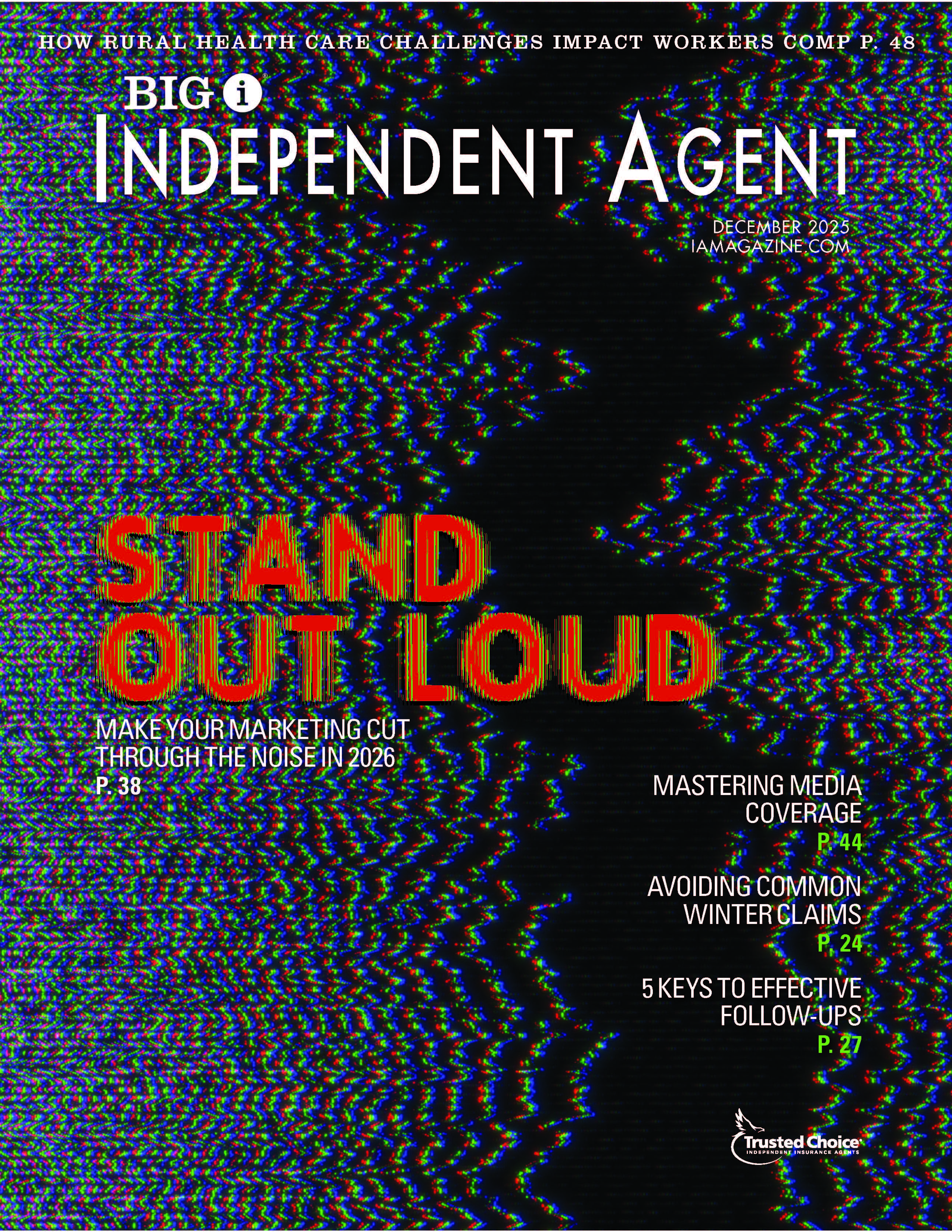Be a Workflow Whiz
By: Susan Hodges
| Jim Hull wants agency owners to give up their books of business. The president of J.R. Hull Co., a Valencia, Calif.-based consultancy, says principals who relinquish their client lists to non-owner producers have more time to manage their agencies—and boost productivity by leaps and bounds. “I find that most agencies are about 50% under-productive,” says Hull, whose specialty is helping small businesses grow. “Principals are usually the biggest sales people in the agency, and they’re already making a lot of money. But their employees are crying out for tools that will make them more efficient.” Tools like improved workflows, which not only increase productivity—and new business as a result—but also play a very important role in preventing E&O problems. While some agents might say the importance of workflows is overrated and that they defy documentation because they change so often, Hull and others say workflows that are standardized and documented lead to sky-high efficiencies that in turn lead to stellar revenue per employee. Living Proof Stratton Agency, Inc., of San Carlos, Calif., sets an example. This nine-person Best Practices agency has an RPE of almost $240,000. “That’s about twice the industry standard,” says James Marek, principal. “And we estimate we can probably add another $5 million or so to the books without adding another employee.” Marek is an owner who enjoys selling, so workflows often get pushed to the back of his plate. That’s why he designated Ryan Headley as chief technology officer (CTO). Among Headley’s latest workflow accomplishments: communication with each personal lines customer 90 to 120 days before renewal. “A lot of agencies say they want to touch base with their personal lines clients but can’t because it’s too time-consuming,” says Headley. “But each time we implement our renewal process three or four times a year, our system automatically generates a letter to each client with an upcoming renewal and sends it by email or hard copy the next morning. The letter directs them to a Web link that when clicked on takes them to a questionnaire on our agency website.” The questionnaire asks for yes-no answers about changes in the client’s situation. If a client enters one or more “yes,” answers, the system sends the questionnaire to the account manager who determines what actions need to occur. If no changes are indicated, the agency’s policy services team receives the questionnaire next, where it is attached to the client’s file. “And through it all, we’ve clicked maybe three buttons,” says Headley. The agency is now rolling out a similar workflow in its commercial lines department. “We like to think of ourselves as a speedboat rather than the Titanic,” says Marek. “We have to be able to react to things quickly. We can’t take six months to change a workflow.” Stratton Agency first benchmarked efficiencies against other agencies three years ago when the firm was nominated as a Big “I” Best Practices agency. Review of the firm’s numbers resulted in Best Practices status. Says Marek, “We always suspected we were highly efficient, but we found that our workflows and technologies are just off the charts.” Why Audit? Once a workflow is finalized and implemented, consistency of use is critical. If each employee is allowed to do things his own way, no one can step in and continue his work during an absence or emergency. That’s why Jan Wood, personal lines manager at Watson Insurance in Gastonia, N.C., audits workflows in her department. Automated processes can be audited easily through the agency management system. But Wood says more complex procedures require a different approach. “I manage my team by listening when someone says they have a problem,” she says. “Then I start observing, listening to phone calls and checking activities to see if one employee has too many accounts or is getting more phone calls than another.” For auditing to be effective, however, Wood emphasizes that workflows must be documented. She and Peggy Summitt, agency support team supervisor, began documenting workflows for the firm’s support team about eight years ago. “We knew we had good people who were hard workers, but we didn’t have a handle on what they did all day long,” says Wood. “So we sat down and asked what the workflows included for every single thing they did, and then we wrote it all down.” Next, Wood and Summitt observed employees working and figured out the average time needed to complete each task. Then Summitt created a matrix, building in time for unforeseen complexities. Work was distributed equally among team members. Results were astounding. “We saw an absolute doubling of the amount of work each person could handle,” says Wood. “They all knew they had the same amount of work, so they knew they were all being held to the same standard. You have to know your numbers and understand your workflows, or you won’t know you have a problem until it hits you in the face.” Watson Insurance recently changed its workflow for vehicle trades in personal lines. “In the past, when someone called to say they traded vehicles, we’d put that in our system on an ACORD change request form, print it off and send it back to our support team,” says Wood. “They’d then go into the carrier website and re-enter the data. The entire process took two to four weeks.” Today when a customer notifies the agency about a vehicle change, an agent enters an activity in the agency management system, where it is electronically transferred to the support team. The team then places that activity into the appropriate carrier’s website, where it is downloaded and processed. “This idea came from Peggy and was a tremendous improvement in our workflow,” says Wood. “It saves five to 10 minutes per request, which is significant when you consider that we have 14 agents handling vehicle changes.” Easing E&O Exposure What would Wood and Summitt tell principals whose agency workflows are not standardized, documented and audited? “That they should give thought to what is their biggest E&O exposure and work backward from there,” says Wood. “You can’t do it all at once unless you’re focused on it full time. But by having goals, completing projects one at a time and staying on task, you’ll soon have everyone doing the same things in the same way. And that will help the agency in the event there is a lawsuit, and it will help with training when someone new is hired.” Adds Summitt, “Standardization helps us be more responsive to our clients. It also helps the agency be more profitable.” GHM Insurance in Waterville, Maine, also audits its workflows. But agency owner Bill Mitchell says the audits rarely uncover problems because there are so few. “One reason we’ve had such good success is because we have checklists in a number of workflows,” he says. Example: a quality-control checklist that originates with producers when they write new business. “The producer goes through and makes sure all steps pertinent to his or her work are completed,” says Mitchell. “The checklist then moves to customer service for creation of the proposal and pulling things together.” Once the entire account is sold to the customer, the checklist is sent to a third person “who checks from beginning to end to make sure that every step has been completed: inspections, signatures and so on,” says Mitchell. It works. The agency has used this quality-control process for 10 years—“and fortunately we’ve never found ourselves in an E&O situation,” says Mitchell. “I think it’s because we’re very diligent in the way we train and execute procedures.” Adjust Your Attitude Mitchell is what Jim Hull would call an “informed owner.” Mitchell’s focus on operational efficiencies is helping GHM Insurance maximize profitability for long-term survival. “When agency owners move to a strategic role, they manage the value of their business,” says Hull. Increasing agency value often leads to increased profitability. And higher profits can provide the resources to hire additional high-quality employees. These workers in turn help the agency operate at an even higher level. “The biggest change that can occur in an agency’s productivity is the owner’s mental model,” says Hull. “If you want your business to move to the next level, you have to get your systems and processes running smoothly. It will make everything easier.” Hull has a final suggestion: As you focus on efficiency through improved workflows, allow your employees to share in the growth that follows. “They’ll end up making more money than their counterparts at other agencies, and that in turn will attract even more capable people,” he says. “And the whole issue of recruiting and hiring just sort of fades away as you and your agency move to a new level.” Susan Hodges is an IA senior contributing writer. | Don’t Forget Training Inside your agency is a sophisticated, computerized management system that probably cost hundreds of thousands of dollars. Why, then, are account managers still assembling proposals from scratch, and producers still composing renewal letters in their heads? Bill Mitchell, owner of GHM Insurance in Waterville, Maine, suggests an answer: Because they aren’t fully trained. “Lack of training is one of the biggest disrupters of productivity,” says Mitchell. “Employees who don’t fully understand workflows and the technology an agency has present a huge hindrance.” Each time GHM Insurance upgrades its technology or converts to a new system, Mitchell and his managers make a major effort to put together new training. “One of the most effective ways we’ve improved our productivity is through automation,” says Mitchell. “We fully use our agency management system for scanning, reporting and accessing carrier information on a real-time basis. But to do that, you’ve got to have training programs that ensure the whole team is up and running. It’s one of the biggest challenges.” —S.H. Fight Snags in the Flow Jason Hoeppner helps agencies smooth out their workflows. In the process he encounters issues that can really dam things up. Like internal operations that don’t have the buy-in of senior management. “Internal operations should be driven from the top down,” says Hoeppner, a consultant with B.H. Burke & Co., Inc., of Westbrook, Conn. “It may take some sit-down-and-think time, but if your agency doesn’t have a clearly defined mission or strategic direction, it needs to. Too often when we see a break in this alignment, it leads to staff working in opposite directions.” According to Hoeppner, not only should senior management set the tone and direction for operations, but it should also empower employees to demand clear communication and consistency from each other. “Producers need to communicate clearly with account managers and account executives, and these staff members need to be free to communicate back to producers when information they need is missing,” he says. “Clearly defined expectations for each position are a must.” Another obstacle Hoeppner often sees is lack of trust or respect between employees due to differing priorities around a sale. “Yes—staff members all have different strengths and weaknesses, but this should be an aid to the selling process, not a potential source of conflict,” he says. If necessary, producers should be required to sit through a quoting session with members of the support staff. Similarly, support staff members should be required to accompany producers on a sales call. On the flip side, Hoeppner says everyone at the agency should be able to deal with exceptions to standard procedures, because they happen. Says Hoeppner, “This is why communication and teamwork are so important.” —S.H. |










